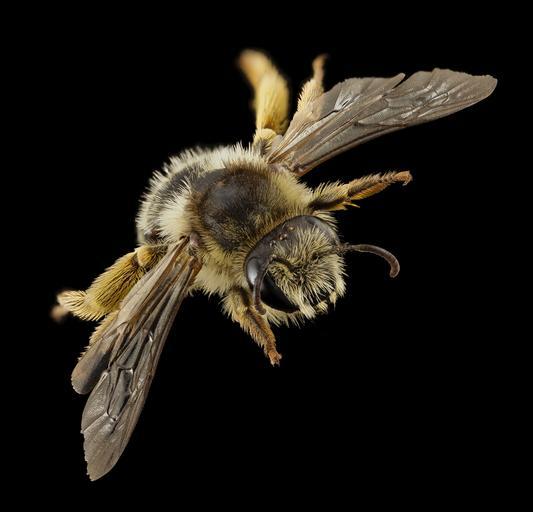MAKE A MEME
View Large Image

| View Original: | Melitta_haemorrhoidalis,_f,_england,_face_2014-11-02-01.23.34_ZS_PMax.jpg (3900x3744) | |||
| Download: | Original | Medium | Small | Thumb |
| Courtesy of: | www.flickr.com | More Like This | ||
| Keywords: bee bees apoidea buzz biml usgs droege canon insect macro macro photography macrophotography insecta hymenoptera england great britain greatbritain wotton-under-edge wottonunderedge campanula flying stackshot zerene stacker zerenestacker europe taxonomy:binomial melitta haemorrhoidalis taxonomybinomialmelittahaemorrhoidalis melitta haemorrhoidalis melittahaemorrhoidalis melitta black background animal outdoor monochrome Melitta haemorrhoidalis, Red-butted Campanula Lover, specimen collected by R.C.L. Perkins in Wotton-under-Edge, England Melitta is the Greek word for bee, and the name of the favorite activity indulged in by the authors – melittology – is based upon this. Melitta bees are specialists. All bees have some preferences for which sorts of pollen they like to gather for their young, some though, like Melitta, take it to the extreme. All the Melitta species that are well known appear to restrict their pollen gathering activities to single species or small groups of closely related species of plants. Thus in North America, there are Mellita that specialize on members of the Heather family, specifically Cranberry, Deerberry, and Maleberry, while elsewhere in the world preferences differ. Our friend the Red-butted Campanula Lover pictured here is the most common of the Melitta species in Europe. As the name implies, it requires patches of Bellflowers to create a successful nest and thus its range overlaps that of these plants. If one looks closely you will see a patch of orangish hairs at the very tail end of the abdomen and you will then know how it got its scientific name and the common name we subsequently gave it. ~~~~~~~~~~{{{{{{0}}}}}}~~~~~~~~~~ All photographs are public domain, feel free to download and use as you wish. Photography Information: Canon Mark II 5D, Zerene Stacker, Stackshot Sled, 65mm Canon MP-E 1-5X macro lens, Twin Macro Flash in Styrofoam Cooler, F5.0, ISO 100, Shutter Speed 200 Further in Summer than the Birds Pathetic from the Grass A minor Nation celebrates Its unobtrusive Mass. No Ordinance be seen So gradual the Grace A pensive Custom it becomes Enlarging Loneliness. Antiquest felt at Noon When August burning low Arise this spectral Canticle Repose to typify Remit as yet no Grace No Furrow on the Glow Yet a Druidic Difference Enhances Nature now -- Emily Dickinson Want some Useful Links to the Techniques We Use? Well now here you go Citizen: Basic USGSBIML set up: www.youtube.com/watch?v=S-_yvIsucOY USGSBIML Photoshopping Technique: Note that we now have added using the burn tool at 50% opacity set to shadows to clean up the halos that bleed into the black background from "hot" color sections of the picture. www.youtube.com/watch?v=Bdmx_8zqvN4 PDF of Basic USGSBIML Photography Set Up: ftp://ftpext.usgs.gov/pub/er/md/laurel/Droege/How%20to%20Take%20MacroPhotographs%20of%20Insects%20BIML%20Lab2.pdf Google Hangout Demonstration of Techniques: plus.google.com/events/c5569losvskrv2nu606ltof8odo or www.youtube.com/watch?v=4c15neFttoU Excellent Technical Form on Stacking: www.photomacrography.net/ Contact information: Sam Droege sdroege@usgs.gov 301 497 5840 Melitta haemorrhoidalis, Red-butted Campanula Lover, specimen collected by R.C.L. Perkins in Wotton-under-Edge, England Melitta is the Greek word for bee, and the name of the favorite activity indulged in by the authors – melittology – is based upon this. Melitta bees are specialists. All bees have some preferences for which sorts of pollen they like to gather for their young, some though, like Melitta, take it to the extreme. All the Melitta species that are well known appear to restrict their pollen gathering activities to single species or small groups of closely related species of plants. Thus in North America, there are Mellita that specialize on members of the Heather family, specifically Cranberry, Deerberry, and Maleberry, while elsewhere in the world preferences differ. Our friend the Red-butted Campanula Lover pictured here is the most common of the Melitta species in Europe. As the name implies, it requires patches of Bellflowers to create a successful nest and thus its range overlaps that of these plants. If one looks closely you will see a patch of orangish hairs at the very tail end of the abdomen and you will then know how it got its scientific name and the common name we subsequently gave it. ~~~~~~~~~~{{{{{{0}}}}}}~~~~~~~~~~ All photographs are public domain, feel free to download and use as you wish. Photography Information: Canon Mark II 5D, Zerene Stacker, Stackshot Sled, 65mm Canon MP-E 1-5X macro lens, Twin Macro Flash in Styrofoam Cooler, F5.0, ISO 100, Shutter Speed 200 Further in Summer than the Birds Pathetic from the Grass A minor Nation celebrates Its unobtrusive Mass. No Ordinance be seen So gradual the Grace A pensive Custom it becomes Enlarging Loneliness. Antiquest felt at Noon When August burning low Arise this spectral Canticle Repose to typify Remit as yet no Grace No Furrow on the Glow Yet a Druidic Difference Enhances Nature now -- Emily Dickinson Want some Useful Links to the Techniques We Use? Well now here you go Citizen: Basic USGSBIML set up: www.youtube.com/watch?v=S-_yvIsucOY USGSBIML Photoshopping Technique: Note that we now have added using the burn tool at 50% opacity set to shadows to clean up the halos that bleed into the black background from "hot" color sections of the picture. www.youtube.com/watch?v=Bdmx_8zqvN4 PDF of Basic USGSBIML Photography Set Up: ftp://ftpext.usgs.gov/pub/er/md/laurel/Droege/How%20to%20Take%20MacroPhotographs%20of%20Insects%20BIML%20Lab2.pdf Google Hangout Demonstration of Techniques: plus.google.com/events/c5569losvskrv2nu606ltof8odo or www.youtube.com/watch?v=4c15neFttoU Excellent Technical Form on Stacking: www.photomacrography.net/ Contact information: Sam Droege sdroege@usgs.gov 301 497 5840 | ||||